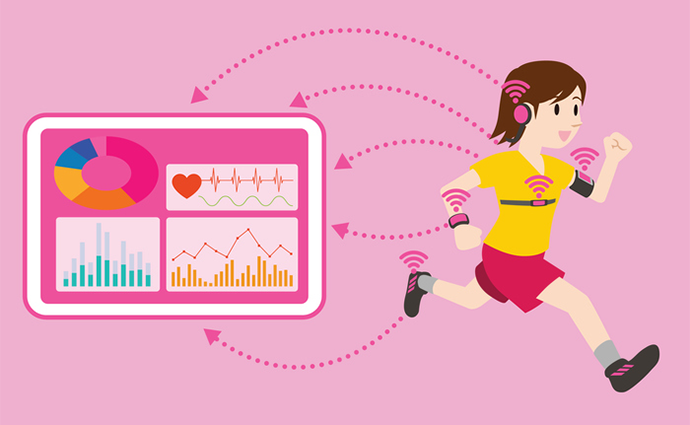Integrating a Telehealth Platform into a Diabetes Prevention Program
Diabetes Prevention Programs, which seek to improve health and wellness for people at risk of developing Type 2 diabetes, are using telehealth to improve access and facilitate better outcomes.

Source: ThinkStock
- Telehealth technology is helping to improve care management and coordination for the estimated 30 million Americans living with diabetes. Now, providers are moving into connected care technology to help more than 84 million at risk of acquiring the chronic disease.
By using a virtual care platform and mHealth devices, providers can expand the range of the Diabetes Prevention Program (DPP) to connect with more people and provide personalized treatment. Health systems, physicians, and community-based groups can use these tools to connect with people in their own homes, offering guidance designed to improve health and wellness.
The challenge lies in creating a telehealth program that will promote consumer engagement while fitting into the provider’s workflow – and defining benchmarks that can promote sustainability and scalability.
How can telehealth support the existing DPP curriculum to extend outreach and bolster the impact of this proven, effective programming?
Dig Deeper:
CMS Embraces mHealth With Reimbursement for Smartphone CGM Links
AHRQ Finds Few Reliable mHealth Apps for Diabetes Care Management
Architecting a DPP Program
The goal in creating a Diabetes Prevention Program is to foster a healthier lifestyle in a population at risk of developing type 2 diabetes, thereby avoiding the negative health outcomes and costs associated with treating this condition.
According to the Centers for Medicare & Medicaid Services, Medicare spent $42 billion more in 2016 on beneficiaries with diabetes than it would have spent if those beneficiaries did not have diabetes. Per beneficiary, Medicare spent an estimated $1,500 more on Part D prescription drugs, $3,100 more for hospital and facility services, and $2,700 more in physician and other clinical services for those with diabetes than those without diabetes.
To address this growing diabetes epidemic, the National Institutes of Health’s National Institute of Diabetes and Digestive and Kidney Disease (NIDDK) developed the Diabetes Prevention Program in the late 1990s.
The Centers for Disease Control and Prevention (CDC) used that model to create the National Diabetes Prevention Program (National DPP), based on an NIH-funded study that showed a reduced incidence of diabetes in at-risk populations who participated in a weight-loss and behavior change program. This enabled healthcare providers to certify their programs and qualify for reimbursement.
The National DPP is a structured intervention consisting of at least 16 CDC-approved sessions taking place over six months in a group-based, classroom-style setting. The classes focus on long-term dietary change, increased exercise and behavior-change strategies for weight control.
Following those sessions, monthly meetings between participants and diabetes educators focus on maintaining those healthy behaviors. The primary benchmark for success is at least 5 percent weight loss.
To create a DPP program, a healthcare provider should first study the curriculum developed by the CDC, then either adopt that curriculum or develop one that will be approved by the CDC. To apply to the CDC for certification, a provider must have at least one certified lifestyle coach on staff, be able to start the program within six months of CDC approval, and must be able to continue the program for at least one year, divided into 16 classroom session during the first six months and six individual session during the last six months.
In addition, the program’s coordinator must be able to track patient progress, measured in attendance, weight loss and physical activity.
During that first year of operation, the CDC will grant the provider “pending” status. At the end of that first year, that status can be upgraded to “preliminary.” And if the program records its outcomes and meets attendance and weight loss targets, it can gain full recognition and qualify for reimbursement.
Adam Brickman, senior director of strategic communications and public policy for Omada Health, a digital therapeutics company that has gained CDC approval for its DPP program, says payer reimbursement “is pretty standard” for DPP programs, though the Centers for Medicare & Medicaid Services has so far declined to reimburse for virtual coaching.
“This is a pretty young benefit, but it’s growing quickly,” he says.
Dig Deeper:
mHealth Gives Pharmacists a Powerful Diabetes Management Platform
mHealth Tools, AI Combine to Avert Serious Diabetic Health Issues

Source: ThinkStock
The Benefits of Adding Telehealth to Preventive Care
While the basic formula for a DPP program consists of classroom sessions followed by in-person meetings between the patient and lifestyle coach, some providers have been adding telehealth to the program to increase access, enable patients to connect from their own homes and make the best use of a limited supply of lifestyle coaches.
Montana’s Department of Public Health & Human Services (MDPHHS) has been using telehealth in its DPP program for several years. Of the 19 sites around the state where DPP classes are held, 13 are telemedicine-accessible.
“Telehealth has been pretty key to our being able to deliver the program to rural areas,” says Sonja Tysk, the department’s DPP coordinator. “And we have a lot of rural area.”
Tysk and Sarah Brokaw, the department’s program manager, say they network with local healthcare providers to stream DPP programs into communities. Using a telemedicine platform, they can hold meetings in libraries, health clinics and other locations, as long as the bandwidth is available.
The format enables the MDPHHS to not only make the best use of its limited number of diabetes educators, but also give residents more opportunities to access the program. Likewise, monthly follow-up sessions via telehealth enable both educator and patient to meet when it’s most convenient for both, regardless of where they’re located, on the mobile device of their choosing. This has the potential to improve patient engagement and compliance, giving educators a better opportunity to ensure that patients don’t drop out of the program.
“Think through each step of the process carefully”when mapping out telehealth integration, Brokaw advises.
This includes choosing a telehealth vendor or product that can accommodate group meetings, training on-site coordinators to handle videoconferencing duties, choosing a site that can handle a private meeting and is easy to access, ensuring bandwidth and mapping out a Plan B - and even a Plan C - should connectivity or power be lost.
“We do have some problems with weather,” Tysk points out.
She also recommends studying the CDC-approved DPP curriculum to make sure it can be adapted to a telehealth class, and making sure there are paper copies of relevant resources available on site for participants.
A telehealth platform can also allow educators to share online resources that participants could access when and where they desire, rather than relying on printed material. It can also enable participants to share data gathered through mHealth devices like smart weight scales, smartwatches and fitness bands – and give educators the opportunity to fashion personalized health and fitness goals through those tools.
When introducing telehealth to a DPP program, it’s important that the connected health technology stay in the background, says Karl Ronn, managing director of Health2047, a California-based business formation and commercialization enterprise launched by the American Medical Association that recently spun out a chronic care company based on the national DPP model.
In developing a one-on-one coaching strategy, Ronn advises providers to steer clear of text messaging and social media platforms that simply push out reminders or words of support.
“Be careful of leading with the technology side of it because it’s just annoying,” he says. “You need a coach – you don’t need reminders.”
Ronn says the focus of a DPP program is on lifestyle change, which requires constant and personal support. Any digital messaging has to be reinforced by personal coaching, so that the messages aren’t read and then ignored.
“This isn’t healthcare,” he says. “It’s personal care. And it’s not a pill or a device. It’s a behavior change. You’re working on something that you will be doing for the rest of your life.”
To Ronn, the benefits of connected care technology in a DPP program are very specific. It can be used to match patients with coaches, it can be used to give coaches an online platform to reach more patients (and to reduce the burdens of travel), and it can be used to gather data at home for coaching support. But it can’t replace the coach.
“Technology can be used to reinforce the coach,” he says. “It can be used to build on those relationships and to reinforce habits.”
Dig Deeper:
Making Telehealth a Valuable Part of Preventive Care Programs
Remote Patient Monitoring Brings mHealth Care Management Into the Home

Source: ThinkStock
Measuring Success With a DPP Program
A successful DPP program helps participants avoid developing type 2 diabetes by engaging in a healthier lifestyle. Weight loss is the most common benchmark, with CDC setting a target of 5 percent at the end of the first year. Other benchmarks include attendance at coaching sessions, increased activity and an improved diet.
CMS currently awards MDPP providers $25 for each beneficiary who attends a “core session.” Providers can then earn $50 for each beneficiary that attends four classes and up to $90 for each member that attends nine classes. CMS also awards providers a higher reimbursement amount for beneficiaries that attend two out of three “ongoing maintenance sessions.”
Healthcare organizations that get members to reach weight loss goals can earn significantly more incentives. Providers earn $160 for every beneficiary who meets the 5 percent weight loss goal. CMS reimburses an additional $25 if beneficiaries achieve 9 percent weight loss. Physicians can earn an additional $60 per beneficiary that completes two ongoing maintenance sessions during month seven and month nine of the program.
CMS also reimburses providers another $60 per beneficiary if the individual completes ongoing sessions in months 10 to 12 of the program.
The most successful providers will receive $670 per Medicare beneficiary for maximum performance outcomes. Providers that simply reach educational goals without weight loss requirements can earn a maximum of $195 per beneficiary.
While Medicare doesn’t currently reimburse for virtual coaching, private payers who adopt these programs have been incorporating mHealth tools into performance measurement.
“Positive outcomes are important, especially when you’re dealing with a senior population,” says Brickman of Omada Health. “You’re looking at weight loss, exercise, better eating habits, but you’re also looking at ancillary or secondary health benefits, such as lower depression and less isolation.”
Brickman says mHealth can be quite useful in tracking those benchmarks. Providers can keep track of a patient’s weight on a daily basis via a wireless scale, or have the patient record daily exercise and meals – even moods – through an mHealth app. They might even suggest tracking data with a wearable, like a fitness sensor or smartwatch.
“This is the most objective way to track someone’s participation in the program,” he says. It also gives the provider a chance to chart daily successes and failures, as opposed to having the patient recount his or her activities over the past few months during the one-on-one meeting. It also gives the provider the opportunity to intervene if the patient is losing interest in the program, or to offer advice and resources when needed.
‘This is a continuing process,” says Brickman, who sees these programs someday being tailored to help with care management for people diagnosed with diabetes. “It’s not like we hit 5 percent weight loss and then we don’t care anymore.”
Dig Deeper:
Using Telehealth, mHealth Technology to Help Seniors Age in Place
Why Consumers Need Info About Diabetes Self-Management Apps

Source: ThinkStock
The Medicare Reimbursement Issue
Brickman notes that the private payer community has been offering reimbursement for DPP programs using telehealth, but the federal government has been far less willing to open the purse strings.
In 2016, following its own pilot program, CMS announced that it would begin reimbursing DPP programs through Medicare in 2018. But the agency noted it would not allow reimbursement for weight management coaching delivered via telehealth, saying “self-reported weight loss is not reliable for the purposes of performance payment.”
The news was tough for the handful of digital health companies - companies like Omada Health, Retrofit, Canary Health, HealthSlate and Noom Coach - looking to scale their programs to the Medicare community.
"Without the inclusion of virtual providers in the benefit, millions of clinically eligible Medicare beneficiaries will not have viable options to access a service which could improve their lives based solely on the zip code in which they reside," Brickman told Politico shortly after the CMS announcement.
In its final rule, however, CMS did leave the door open for future coverage. It announced it would “consider a separate model under CMS’ Innovation Center authority to test and evaluate virtual DPP services.”
Bill Evans, Managing Director for the Digital Health Seed Fund Rock Health, saw the news as a chance for mobile health companies and healthcare providers to collaborate with CMS on value-based care design. He likens the process to the FDA’s “breakthrough designation” for new technology, which allows companies to market their products while still proving efficacy.
“As with FDA, ongoing data gathering would be required, but both patients and innovators would benefit,” he said in a 2017 blog. “Moreover, we’d suggest a step further than FDA’s precedent: Continuous, ongoing performance reporting to CMS.”
“Digital health service providers, in our view, ought to be able to provide ongoing performance data to CMS with little effort,” Evans concluded. “In the bargain, CMS would gain the ability to maintain and perhaps continuously raise outcome-driven performance standards, moving beyond ‘fee for service.’ In addition, by allowing CMS to set performance targets (and reimbursement) based on industry performance data, such a regime has the potential to speed innovation to market on the front-end while spurring free-market driven competition in the long run.”
In early 2018, CMS modified its reimbursement guidelines to include a slight nod to telehealth. The agency decided that DPP programs could be reimbursed for a limited amount of follow-up sessions delivered by virtual health.
Brickman says prospects for Medicaid reimbursement are more hopeful. Both the CDC and CMS have run joint demonstration projects on digital DPP programs for Medicaid populations (most notably in Maryland and Oregon). And several states – including California and Oregon - that are finalizing inclusion of DPP in their state Medicaid benefits in ways that will make virtual providers eligible for reimbursement.
“A program is a program whether it’s being delivered in person or [on a telehealth platform] – the only difference is the delivery method,” Mary Pigatti, CEO of RetroFit and a member of that collation, told mHealthIntelligence.com in a 2016 interview.
CMS “has expanded coverage that will help reduce chronic diseases” and healthcare costs associated with type 2 diabetes, added Pigatti, also the working lead for the Council for Diabetes Prevention’s Digital Working Group. “That’s great. They’re already part-way there. They just need to get all the way there.”
